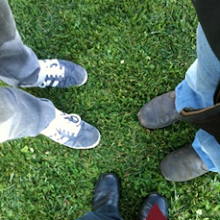Scary fast.
Sounds like a busy bunch of carpenters
at a barn raising!
Only more dramatic THUDS!
Fast double time, triple time
thump! thump! thum-thump! thu-thump!
FAST AS CAN BE!
Does this cantering look soft?
Like lightly tripping across a meadow?
Not likely.
The thu-thump is what thrills me!
I'm in the horse's control,
trusting, going along for the ride.
I have not perfected the one rein stop, yet.
Have not perfected even the plain old stop, yet.
WHOA! WHOA!
That's all I've got.
It's more of a pleading.
I long believed that yanking back on the reins was the trick.
Very upsetting for the horse; very sensitive mouths!
Very patient, gentle horses at my stable.
I'm struggling to grasp that a message from my little finger,
a short gentle, slight wiggle;
This is what alerts the horse to my hope,
that he'll slow down and stop.
See why we take lessons in a round pen;
the horse must turn, no running away.
No galloping away.
Is this the kind of FAST that T loves?
Racing along, almost out of control,
but not quite?
Perfect slowing for corners,
then accelerating at the right moment
gunning it at the apex of the turn,
that floating turn.
He says: Phooey on that SUV,
phooey on that Ford F250.
Can't go flying in those!
How about another turn
in the old biplane?
Down at the air field?
That's flying!
Before the 1880's
no one knew how many legs
of a galloping horse were off the ground .
Old paintings show racing steeds taking great wide leaps,
legs extended out in front and back.
Like flying circus horses, like Pegasus!
Stretched out, flying, with all four feet off the ground.
Stretched out, flying, with all four feet off the ground.
Then the artist Eadweard Muybridge
discovered high speed photography in 1887.
To see what the eye couldn't see.
Look what he discovered:





No comments:
Post a Comment